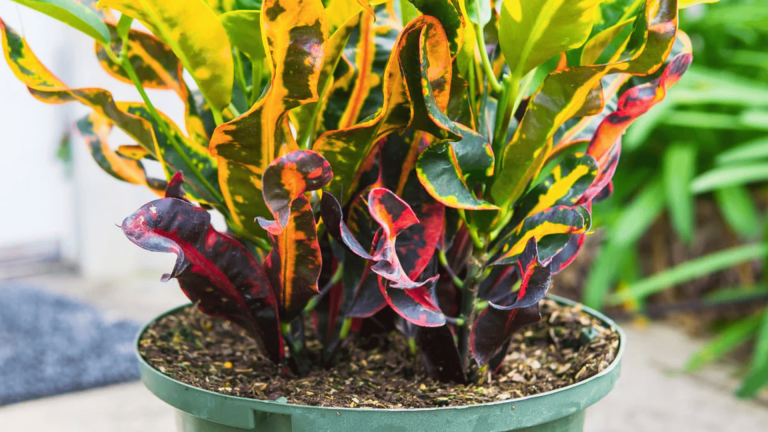Looking for a plant that adds vibrant color and life to your home? The Mammy Croton, with its bold, twisting leaves in shades of red, yellow, and green, is the perfect choice.
This beautiful plant is ideal for anyone wanting a low-maintenance yet eye-catching addition to their indoor or outdoor space.
Once established, the Mammy Croton is easy to care for, but it does need specific conditions to thrive, such as bright sunlight and high humidity.
In this guide, we’ll cover everything you need to know about the Mammy Croton. From its origins and physical features to care tips and troubleshooting advice, we’ve got you covered.
Ready to welcome this colorful plant into your life? Let’s get started!
What is the Mammy Croton?
The Mammy Croton, or Codiaeum variegatum ‘Mammy’, is a colorful tropical plant from Southeast Asia and the Pacific Islands. It is known for its bright, multi-colored leaves.
The Mammy Croton stands out because of its twisted, leathery leaves, which can be red, yellow, green, and purple.
The colors get more intense when the plant gets plenty of sunlight. The leaves have a unique corkscrew shape, making the plant very eye-catching.
Even though it’s called a Croton, the Mammy Croton is actually a variety of the Codiaeum variegatum species. Its appearance and care needs are similar to other Croton plants.
Mammy Crotons can be grown both indoors and outdoors, but they do best in warm, tropical climates.
When taken care of properly, they can grow up to 3 feet tall, making them a great way to add height and color to a space. Their bright leaves make them an attractive plant for any garden or home.
How to Care for Your Mammy Croton

Caring for a Mammy Croton is easy once you know the basics. Here are the essential care tips to help your plant thrive.
1. Watering Needs
Mammy Crotons like their soil to stay moist but not soggy. Water the plant when the top inch of soil feels dry.
Avoid overwatering, as this can lead to root rot. It’s better to underwater than to overwater.
2. Sunlight Requirements
This plant loves bright, indirect sunlight. Place it near a window where it can get plenty of light.
Avoid direct sunlight for long periods as it can scorch the leaves.
3. Temperature and Humidity
Mammy Crotons prefer warm temperatures, between 60°F and 85°F (15°C to 29°C).
They also need high humidity. To keep the air around the plant moist, consider using a humidifier, misting the leaves, or placing the pot on a tray filled with water and pebbles.
4. Soil and Fertilizer
Use well-draining, rich soil, like a mix designed for tropical plants.
Fertilize with a balanced liquid fertilizer once a month during the growing season (spring and summer).
You don’t need to fertilize as often in the fall and winter when the plant is resting.
With these simple care steps, your Mammy Croton will grow healthy.
Size and Growth of Mammy Croton
Mammy Crotons are medium-sized plants that can grow both indoors and outdoors, but their size and growth can vary depending on the care they receive.
Growth Potential
Mammy Crotons typically grow to about 3 feet tall when kept indoors. Under the right conditions, they can grow a bit taller, up to 5 feet, outdoors.
Growth Rate
They have a moderate growth rate. With proper care, you’ll notice new growth every few months. However, it may take some time to reach its full height, especially when grown indoors.
Pruning and Maintenance
Regular pruning is important to keep the plant looking its best. Prune off any dead or damaged leaves and shape the plant to maintain a bushy, attractive appearance.
Pruning also helps the plant grow more vigorously and prevents it from becoming too leggy. For the best growth results, keep the plant in a spot with good light and high humidity.
With the right care, your Mammy Croton can become a beautiful addition to your home or garden.
Propagation of Mammy Croton
If you’d like to grow more Mammy Crotons, propagation is an easy and effective way to do it. The best method is through stem cuttings, and here’s how you can do it:
Cutting Method: Stem cuttings are the most reliable way to propagate a Mammy Croton. This method ensures that the new plant will have the same colorful leaves and characteristics as the parent plant.
Step-by-Step Process
- Select a Healthy Stem: Choose a healthy stem with a few leaves attached. Cut a 4-6 inch section from the tip of the stem.
- Prepare the Cutting: Remove the lower leaves from the cutting, leaving just a few leaves at the top.
- Use a Rooting Hormone: Dip the cut end in rooting hormone to encourage root growth.
- Plant the Cutting: Place the cutting in a pot filled with well-draining soil. Make sure the cut end is buried about an inch deep.
- Create Humidity: Cover the cutting with a plastic bag or place it in a humid environment to keep the air around it moist.
- Provide Indirect Light: Keep the cutting in a warm spot with bright, indirect light.
- Transplant: Once roots have developed, usually in a few weeks, you can transplant the new plant into a larger pot or outdoors, depending on the climate.
With proper care, your new Mammy Croton will take root and grow just like the original.
Pet Safety and Toxicity
Mammy Crotons are beautiful plants, but they do require some caution, especially when it comes to pets.
Toxicity Warning
Mammy Crotons are considered toxic to both pets and humans.
The plant contains a milky sap that can be irritating if ingested or if it comes into contact with the skin, leading to symptoms such as nausea, vomiting, or skin rashes.
Precautions
To keep your pets safe, it’s important to place the Mammy Croton out of their reach.
If you have curious pets who tend to chew on plants, consider putting the plant in a high spot or using barriers to prevent them from getting too close.
While the plant is toxic, accidents can be avoided with careful placement and monitoring.
Always wear gloves when handling the plant, and wash your hands thoroughly afterward to prevent irritation.
By following these precautions, you can enjoy the beauty of your Mammy Croton while keeping your pets safe.
Common Problems with Mammy Croton
Like all plants, the Mammy Croton can face a few challenges, but with the right care, most issues can be avoided or fixed. Here are some common problems you might encounter.
Pests and Diseases
Mammy Crotons are generally pest-resistant, but they can still be affected by common houseplant pests like spider mites, mealybugs, and scale insects. Overwatering can also lead to root rot.
Troubleshooting
- Yellowing Leaves: This is often a sign of overwatering or poor drainage. If the plant’s roots stay too wet for too long, the leaves can turn yellow and drop off. Make sure the soil is well-drained and allow it to dry out between waterings.
- Leaf Drop: A Mammy Croton may drop leaves if it’s stressed by low humidity or inconsistent watering. Ensure the plant is kept in a humid environment and water it regularly without overdoing it.
- Leaf Burn: If the leaves of your Mammy Croton start to brown or get scorched, it could be a result of too much direct sunlight. Place the plant in a spot with bright, indirect light instead.
Preventative Care
To avoid most problems, provide consistent care: use well-draining soil, maintain high humidity, and keep the plant in bright, indirect light.
Regularly inspect for pests and remove them promptly. This will help keep your Mammy Croton healthy.
Indoor vs. Outdoor Growth of Mammy Croton
Mammy Crotons can thrive both indoors and outdoors, but they do best in specific conditions. Here’s what you need to know about growing them in each environment.
Indoor Conditions
Mammy Crotons are perfect for indoor spaces, especially if you have a spot that gets bright, indirect sunlight. They can be grown in containers or pots, making them easy to move around.
Indoors, they need consistent humidity and warm temperatures to flourish. Keep them away from cold drafts or air conditioners that can dry them out.
Outdoor Conditions
If you live in a warm climate (USDA zones 10-11), Mammy Crotons can also be grown outdoors. They thrive in areas with bright sunlight and high humidity, such as tropical or subtropical gardens.
They are well-suited for landscapes, especially in areas where they can get plenty of sun and moisture.
Cold Tolerance
Mammy Crotons are not frost-tolerant. If temperatures drop below 50°F (10°C), the plant may suffer damage.
If you live in colder climates, bring the plant indoors before frost arrives.
Benefits of the Mammy Croton Plant
Mammy Crotons are not only visually appealing but also offer several benefits for your home or garden. Here are some of the key advantages of having this plant.
- Aesthetic: With its bright, multicolored leaves, the Mammy Croton adds bold color and texture to any space. It’s perfect for brightening up your home or garden with its striking, eye-catching foliage.
- Air Purification: Like many houseplants, the Mammy Croton can help improve indoor air quality by removing toxins. It’s a natural air purifier, making it a great addition to your living space for both beauty and health.
- Low Maintenance: Once established, the Mammy Croton is relatively easy to care for. It requires only moderate watering, bright light, and regular humidity. Its low-maintenance nature makes it suitable for both beginners and experienced plant owners.
- Privacy: The Mammy Croton’s dense, bushy growth makes it an excellent option for creating privacy screens or as an ornamental plant in both indoor and outdoor spaces.
- Versatility: Mammy Crotons can be grown in containers, making them ideal for both small indoor spaces and larger outdoor gardens. Their flexibility allows them to fit into a variety of environments and garden styles.
Conclusion
The Mammy Croton is a colorful and easy-to-care-for plant that can bring a unique touch to your home or garden.
With its bright, twisted leaves and simple care requirements, it’s perfect for both beginners and experienced plant lovers.
This plant thrives in bright light and can be grown indoors or outdoors, making it a versatile addition to any space.
Its low-maintenance nature means that it doesn’t require constant attention, allowing you to enjoy its beauty with minimal effort.
If you’re ready to add a Mammy Croton to your space, go ahead and bring one home. It’s a great way to add some color and life to any room or garden.
For more plant care tips and gardening advice, be sure to check out our other blogs!













